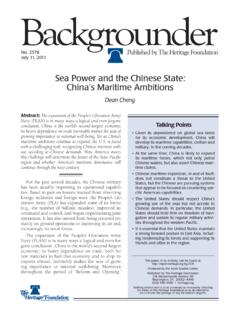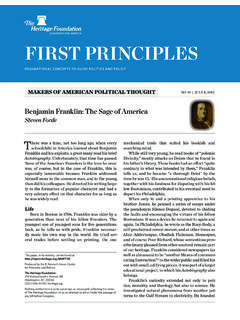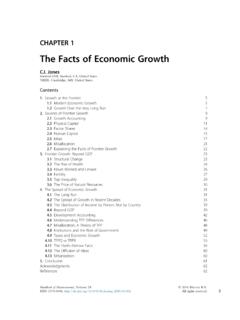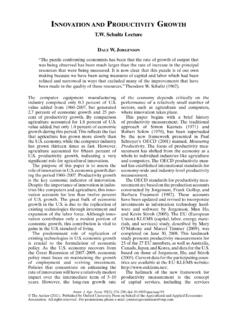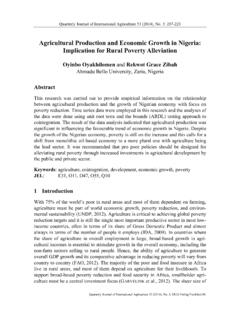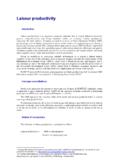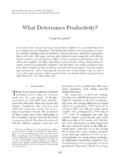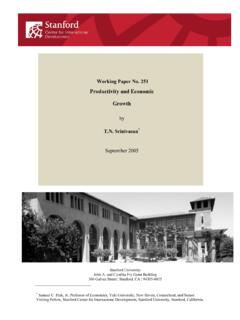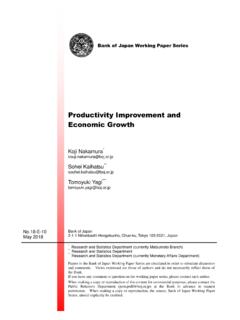Transcription of Productivity and Compensation: Growing Together
1 BACKGROUNDERKey PointsProductivity and compensation : Growing TogetherJames SherkNo. 2825 | July 17, 2013 Today, many policymakers believe mistakenly that employees no longer to enjoy the fruits of their labor. They contend compensation growth has lagged far behind produc-tivity growth . The claims are false. They rest on mistaken comparisons of economic data. Looking at total compensa-tion including benefits and using consistent measures of inflation eliminate over three-quarters of the apparent gap between pay and Productivity . Government policies should focus on measures that enable Americans to become more productive and command higher pay such as reducing the cost of higher education, or reducing regulatory costs that slow the economic recovery and labor wisdom holds that worker Productivity has risen sharply since the 1970s while worker compensation has stagnated.
2 This belief rests on misinterpreted economic data. Accurate and careful com-parisons show that over the past 40 years measured Productivity has increased 100 percent and average compensation has risen 77 percent. Inflated Productivity measurements account for most of the remaining 23 percentage point difference. An apples-to-apples comparison shows that employee compensation continues to closely follow Productivity . American workers continue to earn more as they become more produc-tive. To help Americans advance economically, policymakers should seek policies that will increase John F. Kennedy believed that a rising tide lifts all boats, but many question if that remains true today. They point to data showing that Productivity has risen sharply since the 1970s while wages have stagnated.
3 They conclude that productivi-ty-driven economic growth does not necessarily benefit American workers. These claims rest on misinterpreted economic statistics. They juxtapose Productivity and pay1 data that cannot be directly com-pared, leading to inaccurate conclusions. The claim that pay has lagged far behind Productivity growth : Examines wage growth instead of total compensation , which includes rapidly Growing benefits;This paper, in its entirety, can be found at by the Center for Data AnalysisThe Heritage Foundation214 Massachusetts Avenue, NEWashington, DC 20002(202) 546-4400 | written here is to be construed as necessarily reflecting the views of The Heritage Foundation or as an attempt to aid or hinder the passage of any bill before | NO. 2825 July 17, 2013 uses different price indexes to adjust pay and pro-ductivity for inflation; Omits the effect of faster depreciation, which reduces net income but not gross Productivity ; and Ignores known measurement errors in Bureau of labor Statistics (BlS) Productivity careful comparisons show that measured Productivity has increased 100 percent and average compensation has risen 77 percent over the past 40 years.
4 Issues inflating Productivity measurements account for most of the remaining 23 percentage point difference. An apples-to-apples comparison shows that employee compensation continues to closely follow Productivity . Workers are earning more as they become more fact has important policy implications. Many policymakers mistakenly believe that employ-ees are destined to no longer enjoy the fruits of their labor, even if the economy returns to full employ-ment. They have turned their attention to redistrib-utive economic policies to compensate. Better poli-cies would focus on measures that enable Americans to become more productive and command higher pay such as reducing the cost of higher education, or reducing regulatory costs that slow the economic recovery and labor compensation .
5 Workers Pay Not Tracking Productivity ?Some analysts argue that employees have not benefitted from Productivity growth over the past generation, contending that even as workers have become more productive their pay has stagnated. left-leaning think tanks like the economic Policy Institute,2 columnists like Paul Krugman,3 and pol-iticians like Senator Elizabeth Warren (D MA),4 among others,5 have all made variations on this argument. The belief underlying many liberal poli-cies is that if employees cannot get ahead through hard work and Productivity , government interven-tion becomes an appealing alternative. Many academic and policy researchers dispute this conclusion. Harvard Professor Martin Feldstein, the former President of the National Bureau of economic Research, concluded that the apparent divergence results from using the wrong data to mea-sure pay and using the correct data, he finds that pay and Productivity have both grown Together .
6 Dean Baker, director of the left-leaning Center for economic and Policy Research, and staff at the Federal Reserve Bank of St. louis also come to that Georgetown Professor Stephen Rose likewise finds that the apparent gap between pay and Productivity collapses under He concludes that economic growth resulting from productiv-ity growth continues to benefit working Americans. Most economists believe that employers generally set pay levels according to worker Productivity , though 1. Throughout this Backgrounder, the term pay refers to the total compensation offered to employees, including non-cash benefits, while wages refers solely to cash Lawrence Mishel, The Wedges Between Productivity and Median compensation growth , economic Policy Institute Issue Brief No. 330, April 26, Paul Krugman, compensation Too, The Conscience of a Liberal, July 18, 2012, (accessed June 24, 2013).
7 4. Questions posed by Senator Elizabeth Warren at the Senate Health, Education, Labor, and Pensions Committee hearing on, Keeping up with a Changing Economy: Indexing the Minimum Wage, March 14, 2013, (accessed June 24, 2013). 5. Mark Thoma, The Wedge Between Productivity and Wages, Economist s View, April 28, 2012, (accessed June 24, 2013). 6. Martin Feldstein, Did Wages Reflect growth in Productivity ? Journal of Policy Modeling, Vol. 30, No. 4 (2008), pp. 591 594. Specifically, using different measures of inflation to measure real pay and real Productivity and examining wages instead of total Dean Baker, Behind the Gap Between Productivity and Wage growth , Center for economic and Policy Research Issue Brief, February 2007, (accessed June 24, 2013), and Richard Anderson, How Well Do Wages Follow Productivity growth ?
8 Federal Reserve Bank of St. Louis economic Synopses No. 7, 2007, (accessed June 24, 2013). 8. Stephen Rose, Does Productivity growth Still Benefit Working Americans? Unraveling the Income growth Mystery to Determine How Much Median Incomes Trail Productivity growth , The Information Technology and Innovation Foundation, June 2007, (accessed June 24, 2013).3 BACKGROUNDER | NO. 2825 July 17, 2013a temporary gap may develop during periods of high unemployment such as the nation is now experiencing. compensation Rising with ProductivityEconomic theory holds that competition among employers forces them to pay workers according to their Productivity . In this sense, the market for labor services operates like any other competi-tive marketplace in the economy. Businesses that pay their workers less than they produce will see their workforce jump to higher-paying competi-tors, while businesses that pay their workers more than they produce earn inadequate returns, lose money, or even go bankrupt.
9 As a result, workers pay should closely track their Productivity over economic statistics confirm this predic-tion: Employee compensation has largely grown in tandem with labor Productivity over the past two generations. Productivity rose 100 percent between 1973 and 2012, while hourly employee compensa-tion rose almost as much 77 percent. As discussed below, measurement problems that inflate reported Productivity account for most of the remaining dif-ference. Workers have shared in the gains from high-er Productivity . Chart 1 shows compensation and Productivity growth over the past 40 years. The y-axis shows a CHART 1 Source: Heritage Foundation calculations using data from the Department of Labor, Bureau of Labor Statistics, Productivity and Costs, (accessed June 15, 2013).
10 Productivity and compensation are for nonfarm businesses and adjusted for inflation using the implicit price deflator. LOG INDEXT otal compensation Rises with 2825 Q Q Q Q Q Q Q Q Q Q ProductivityCompensation+100%+77%Change since Q 4 BACKGROUNDER | NO. 2825 July 17, 2013logged index of hourly compensation and productiv-ity, with 1973 as the base (In 1973, the trend in Productivity growth slowed, and many analysts argue a divergence between pay and Productivity began that year.) However, as Chart 2 shows, while Productivity has sometimes grown faster than com-pensation, and vice versa, over time, the two have risen Together . Chart 2 shows average quarterly Productivity and compensation growth rates (expressed as annu-alized rates). Since 1973, Productivity has risen at an average annual rate of percent.
